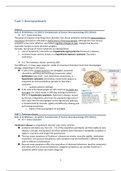Samenvatting
Summary Task 7: Neuropsychiatry (GGZ2025; neuropsychological disorders)
- Instelling
- Maastricht University (UM)
Task 7: Neuropsychiatry (GGZ2025; neuropsychological disorders). All literature has been used. Available in bundle!
[Meer zien]




